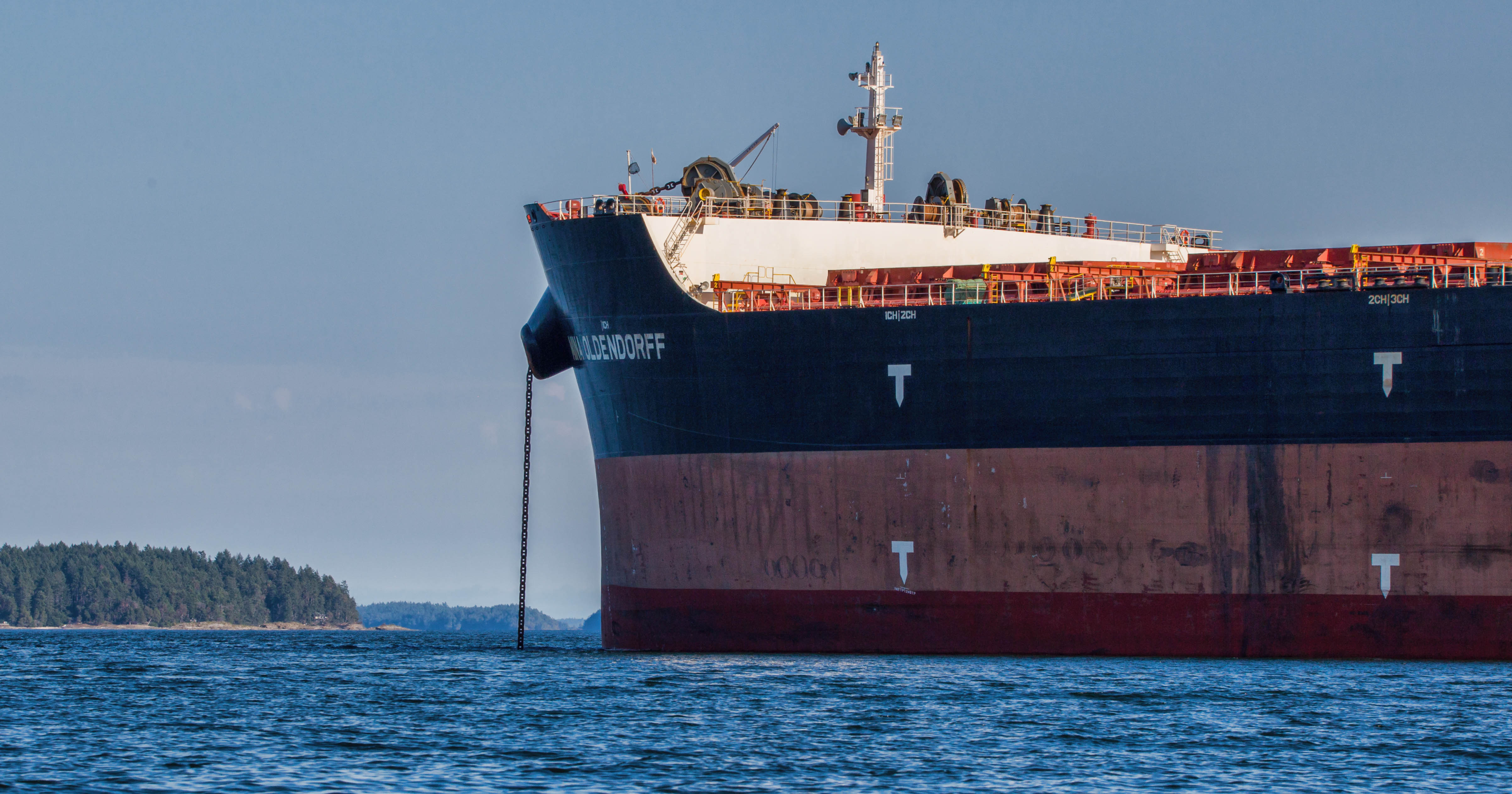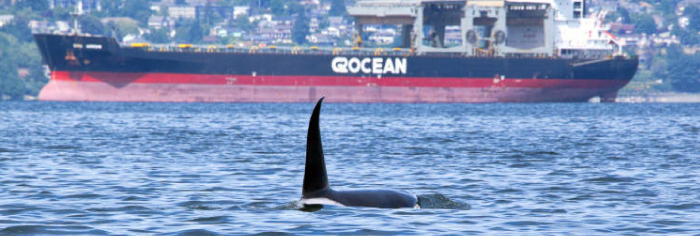
photo: Chris Straw
There are 33 freighter anchorages in the Southern Gulf Islands and Cowichan Bay and the federal government is currently considering adding more. The anchorages sites are free, long-term, overflow parking spaces for mostly, internationally owned grain and coal ships, waiting for berths in Port of Vancouver. Because they are outside of the federally regulated Port of Vancouver’s jurisdiction, they have very little oversight or regulation.
There’s currently no limit on how long they can stay (sometimes 30-40 days before heading into the port.) These sites were designated in the 1970s for use by much smaller vessels visiting Ports on Vancouver Island. They were put on the map without consultation with First Nations or other coastal residents and have had no environmental assessments.
Trade and marine shipping is very important, but Canada must balance commercial ship management with marine protection. Empty ships at anchor in the Southern Gulf Islands contribute nothing to the national or local economy. Ships make money for Canada when they are in the port, not when they sit idle for weeks outside of the port.
Use of anchorages is increasing at more than 3 times the rate that bulk cargo export rates through the Port of Vancouver. Everyone would benefit from an improved and more efficient supply chain. The situation negatively impacts the marine environment, including southern resident killer whales and many other species.

photo: Chris Straw
Here are some of the risks:
Large scale fuel spills
As freighters travel through the narrow passages and channels in the region and at times face high winds, there is an ever-present risk of ships grounding or colliding with other vessels, leading to catastrophic fuel spills.
Danger for Killer Whales
Ships travel through the critical habitat of the Southern Resident Killer Whales to get to these anchorages. This adds to acoustic interference and potential for ship/whale collisions.
Anchor Chain Scour
As ships slowly swing around their anchor, their large anchor chains scour the ocean floor. This destroys important marine habitat.
Air Noise and Light Pollution
On-board diesel generators run 24/7 pumping harmful emissions into the local air shed and creating constant, excessive noise. Ship lighting systems run all night and interfere with animals and humans.
Other pollution
Despite international regulations, ships at anchor have been known to dump toxic contaminants and invasive species into local waters.
What you can do?
Send a letter to key government ministers, and then share the message that you did via email and social media. We must work towards keeping shipping activities inside regulated Port areas where there is oversight and monitoring.
 Posted on behalf of The South Coast Ship Watch Alliance.
Posted on behalf of The South Coast Ship Watch Alliance.
SCSWA is a coalition of community groups in the Southern Gulf Islands, Cowichan Bay, Ladysmith and Saltair. The alliance includes environmentalists, concerned citizens, homeowners and residents who are sounding the alarm about bulk freighters anchoring in local waterways and the many negative impacts they are having on the environment and communities in the region.

Get rid of those ugly ships anchored in Cowichan Bay with their noise, pollution and damage toy the marine ecosystem!
It’s an algorithm that’s used to designate where the ships are anchored by the Port of Vancouver.
Because of the protests on rail lines across Canada, they are all delayed . Anchorages are full.
What do you suggest ? You & I purchase many of the products that are delivered by those ships, as well as grain, coal etc Canada ships for export.
Unfortunately because of the protests, they are delayed resulting in them being anchored for longer periods.
The issue of the use of anchorages in the Gulf Island precedes the current impacts from global and local happenings. The location of the anchorages is no longer appropriate, which is why we’re asking for a review of their location and consider moving some of them to other parts of the region. We also need to talk about the supply chain and why a ship can park – for free – for weeks or months on end in the Salish Sea. Other ports in the world have ‘just in time’ rules which means ships can’t come in until products are ready for pick up. It puts the onus on shippers to manage the ships movements. Here, we don’t do that and the local environment and communities pay the price. We must have a review of the entire system as it’s currently broken.
On Feb 7th I counted 31 freighters anchored between Nanaimo and Cowichan Bay on my Vessel finder app.
I also see zero anchored in the San Juan Islands. Does anyone know what regs pertain to the USA to curb this practice?
It’s an algorithm that’s used to designate where the ships are anchored by the Port of Vancouver.
Because of the protests on rail lines across Canada, they are all delayed . Anchorages are full.
That’s very interesting that you don’t see them in the San Juan’s, other then there maybe a whole Customs flag there. does international ships going into Seattle harbour drop anchor there do you know?
Miles Arsenault
Bay to Bay Charters
miles@baytobay.ca
http://www.baytobay.ca
Ph. 250-217-4001
Last year there were a lot of freighters ‘ so I tried to discover why so many at anchor. I was told the freght of freighters was held up because the trains were being diverted tp carry ‘bulk petroleum’ to the USA and it was not changed until the grain lobbys yelled ouch..and ‘feds’ changed it….so..we have inherited this program.
YOU HAVE TO BE KIDDING ? ! ? Noooooo o o o…….. The noise, spills, filth, fumes are not acceptable NOW. This would be like asking the fox to look after the chicken coop. DO NOT DO THIS ! ! !
TOTALLY IRRESPONSIBLE.
Has anything transpirred since these observations were posted 4 years ago?
Yes! In December the NDP announced amendments to Bill C-33: the Strengthening the Port System and Railway Safety in Canada Act, that will require vessels to be directed out of the area if they have been anchored there for longer than 14 days. This is the correct direction to be going! We’re getting closer to balancing ship management with marine protection. A I4-day limit on anchorages will encourage more shipping activities to be done within regulated Port areas, where there is oversight and monitoring. Find out more @ Victoria News: Anchored ships will soon have time limits off Vancouver Island shores: MP & Ship Watch We should also flag that the Port has been leading a process to better manager vessels coming in and out of the Port, which we hope will reduce the need for anchorage. The one concern we have is through that consultation process, the Port is now likely to be given oversight of the anchorages. There could be benefits but also there is to having the industry manage itself.